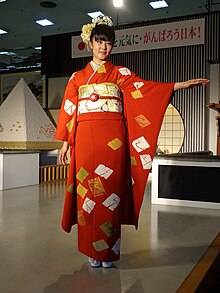
Back فوريسوده Arabic Furisode Esperanto Furisode Spanish Furisode French פוריסודה HE Furisode ID Furisode Italian 振袖 Japanese Furisode JV 후리소데 Korean


A furisode (振袖, lit. 'swinging sleeves') is a style of kimono distinguishable by its long sleeves, which range in length from 85 cm (33 in) for a kofurisode (小振袖, lit. 'short swinging sleeve'), to 114 cm (45 in) for an ōfurisode (大振袖, lit. 'large swinging sleeves'). Furisode are the most formal style of kimono worn by young unmarried women in Japan.[1]
The sleeves, like all women's kimono, are attached to the body of the kimono only at the shoulder, with the inner edge left open past the shoulder. This both allows the underkimono (juban) to show when worn, and also allows the obi to be tied around the body above the hips. Furisode, like other formal kimono, are mostly made from silk, and are decorated in bright colours to reflect the wearer's youth. Furisode are often either rented or bought by parents for their daughters to wear on Coming of Age Day in the year they turn 20.
In previous decades, in particular before WWII, only young unmarried women wore furisode, as marriage signified the end to a woman's single youth and the beginning of her transition into married life; higher rates of marriage at a younger age left few women unmarried past their mid-twenties, meaning that furisode were never seen on older unmarried women. Though furisode were worn to formal events, informal furisode – sometimes featuring shorter sleeves and more subdued decoration – did exist, and would have been worn to less formal events, or as a part of everyday life.
In the present day, furisode are by default considered to be formalwear, despite the existence of some yukata (informal summer kimono) with furisode-style sleeves; the furisode is generally worn for formal social functions such as tea ceremonies and weddings.[2]
Formality guidelines for kimono have also relaxed, to the point that the divide between wearing furisode and other types of formal kimono is now one more of age, rather than marital status, with young women past their early twenties generally wearing shorter sleeved kimono instead. Both married and unmarried young women also have the choice to wear other types of formal kimono featuring shorter sleeves to formal events, such as the short sleeved irotomesode, as well as wearing formal Western clothing rather than kimono.
- ^ "Furisode Kimono". Kimonogeisha.com. Archived from the original on 2018-05-30. Retrieved 2018-05-18.
Furisode kimonos are exclusive to unmarried young women.
{{cite web}}: CS1 maint: unfit URL (link) - ^ "What's a Furisode?". All About Japan. 2017-01-08. Retrieved 2018-05-18.